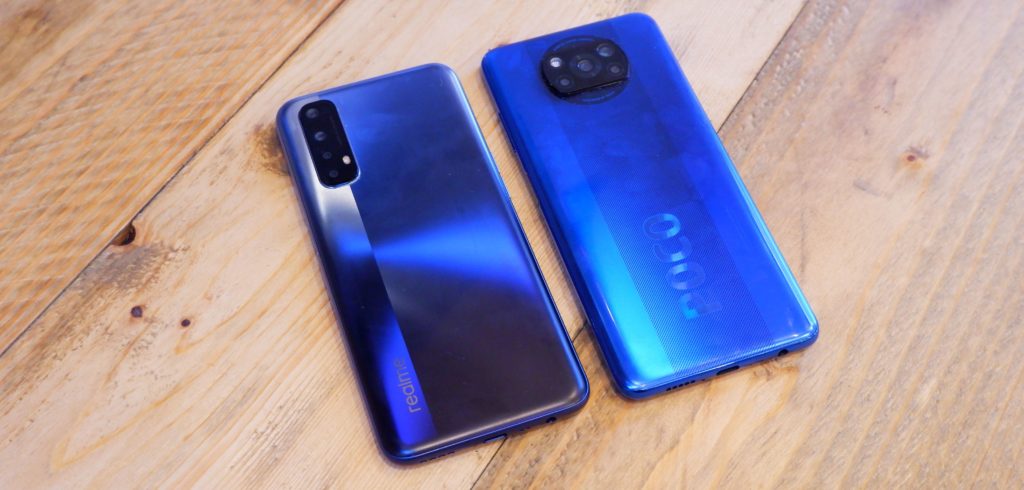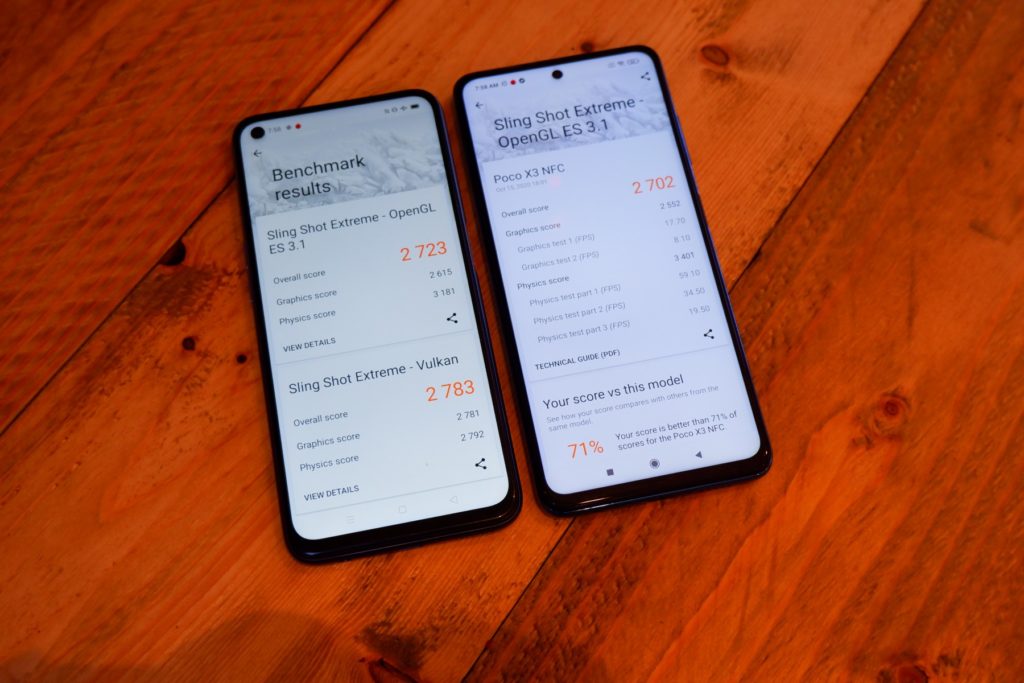I doubt it is a coincidence that both Realme and Xiaomi launched two similarly priced devices using new customised chipsets from different brands that offer similar levels of performance.
The two brands seem to be battling it out, trying to be the best brand for the best spec possible for the money you pay.
The strategy is obviously working well for them both, they have seen exponential growth in recent years and with the current economic climate, many people will no doubt be looking at more affordable alternatives to the ever-increasing price of premium flagship devices.
Poco X3 NFC vs Realme 7 vs 7 Pro

| Preview | Product | Rating | Price | |
|---|---|---|---|---|
 |
POCO X3 NFC – Smartphone 6+64GB, 6,67” FHD+ Punch-hole… | No ratings yet | £199.00 | Buy on Amazon |
 |
realme 7 Mist Blue, 6+64GB, 6.5” FHD+ Full Screen Display,… | No ratings yet | £199.00 | Buy on Amazon |
 |
realme 7 Pro Mirror Silver, 8+128GB, 6.4” AMOLED Full… | No ratings yet | £279.00 | Buy on Amazon |
The Realme 7 launched at £179 and £199 while the Poco X3 NFC is £199 and £249 so they are not quite the same, with the Poco sitting in the middle with the Realme 7 Pro being £279
While the Realme 7 has the advantage in terms of price, the Poco X3 makes up for it with a better specification overall
- The Poco X3 has a 120Hz display vs 90hz, and it is bigger too
- It has an IP53 splash proof rating
- The primary camera is a 64MP Sony IMX682 vs a 48MP Samsung GW 1
- The ultra wide-angle camera is 13MP vs 8MP
- The battery is fractionally larger at 5160 mAh vs 5000 mAh
- Charging is fractionally better at 33w vs 30w
Then, of course, is the chipset difference, and the below benchmarks will try and find out which is best.
As for the Realme 7 Pro, that justifies its higher price with a beautiful AMOLED display and 65W charging (though it uses the SD720G which is definitely slower than the SD732G on the Poco).
Chipset Specification
| SD 732G | SD 720G | Helio G95 | Helio G90T | |
| Frabircation Process | 8nm | 8nm | 12nm | 12nm |
| CPU | 2x Arm Cortex-A76 @ x 2.3 GHz 6x Arm Cortex-A55 @ 1.8 GHz |
2x Arm Cortex-A76 @ x 2.3 GHz 6x Arm Cortex-A55 @ 1.8 GHz |
2x Arm Cortex-A76 @ x 2.05 GHz 6x Arm Cortex-A55 @ 1.2 GHz |
2x Arm Cortex-A76 @ x 2.05 GHz 6x Arm Cortex-A55 @ 1.2 GHz |
| GPU | Adreno 618 @ 950Mhz | Adreno 618 500 MHz | Mali-G76 3EEMC4 @ 900Hz | Mali-G76 3EEMC4 @ 800Hz |
| Memory | LPDDR4X 1866MHz |
LPDDR4X 1866 MHz |
LPDDR4X 2133MHz |
LPDDR4X 2133MHz |
I have been a little critical of these chipsets, both Qualcomm and MediaTek seem to launch chipsets for the sake of it, offering incremental improvements.
With these two, it appears to be a customised chipset for each respective brand, offering the smallest of improvements possible. On the one hand this seems to be a frustrating marketing gimmick, but at the same time, as a consumer, you are getting a bit more performance vs them reusing the existing chipsets.
With Qualcomm, there is actually the SD730G, SD720G and SD732G which are all almost identical. While Google recently resurrected the forgotten about SD730G on the Pixel 4a, both Xiaomi and Realme have been using the SD720G in recent phones, which is why I am comparing that.
Looking at the specs, it appears that the Qualcomm chipset offers the greatest gain, with a 90% improvement in GPU frequencies vs 12.5%. Neither chipset offers any improvement on the CPU.
Benchmarks
Antutu Benchmark
| SD 732G | SD 720G | Helio G95 | Helio G90T | |
| CPU | 101152 | 104143 | 97423 | 98263 |
| GPU | 78748 | 70801 | 83882 | 79755 |
| Mem | 52987 | 52273 | 54415 | 57285 |
| UX | 52463 | 55119 | 59346 | 45992 |
| Total | 285350 | 282336 | 295066 | 281295 |
In Antutu, the score I achieved on the Poco X3 was quite a bit lower than the score posted during the product announcement, and the total score isn’t that different from the SD720G. However, looking at the breakdown of scores there is an 11% improvement in the GPU but there is a 3% reduction in the CPU, which goes to show how synthetic benchmarks can often produce unexpected and possible inaccurate results.
There is a 5% gain moving from the G90T to the G95 but this result is skewed by a massive increase in the UX score.
Geekbench 5 Benchmark
| Single Core | Multi Core | |
| POCO X3 NFC – SD732G | 568 | 1771 |
| Realme 6 Pro – SD720G | 568 | 1643 |
| Realme X2 – SD730G | 546 | 1729 |
| Realme 7 – Helio G95 | 516? | 1650? |
| Realme 6 – Helio G90T | 516 | 1650 |
With Geekbench, I never got it to work fully on the Realme 7, but with the CPU spec being the same we can assume it will have the same results as the Realme 6 running the Helio G90T.
When looking at the Poco we se an identical result for the single core vs the SD720G, as expected, but an 8% increase on the multi core. Again this is likely just the quirks of benchmarks running on different phones.
PC Mark 2.0
- Poco X3 with SD732G – 8325
- Xiaomi Redmi Note 9 Pro with SD 720G – 7829
- Realme 7 with Helio G95 – 9807
- Realme 6 with Helio G90T – 9967
Realme achieves over-inflated numbers in PC Mark, their smart mode profile locks the CPU frequency, so I have used the Xiaomi Redmi Note 9 Pro which is a more reliable 7829.
In this test, the SD732G offers a 6% improvement over the SD720 while the G95 actually loses out to the older G90T.
3D Mark

3D Mark seems to have changed a bit recently, with new benchmarks but for the sake of this I have stayed with the Slingshot Extreme OpenGL
- Poco X3 with SD732G – 2702
- Realme 7 Pro with SD 720G – 2507
- Realme 7 with Helio G95 – 2723
- Realme 6 with Helio G90T – 2537
In this test, both chipsets offer a similar performance uplift vs their predecessor with 7.8% for the Qualcomm and 7.3% for MediaTek.
Overall
While both chipsets have seen some marginal gains, the synthetic benchmarks indicate that the differences are small enough not to matter. I doubt many would notice any real-world performance benefits.
Furthermore, in my opinion, the overall performance different between Qualcomm and MediaTek is negligible with just a 3% difference in Antutu on the new chipsets. It certainly not enough to justify the fanboyism that some users exhibit when talking about either chipset brand.
Neither chipset brings much new to the table, but they are both superb, offering more than enough performance for the vast majority of us while keeping prices affordable.
Posted by Mighty Gadget Blog: UK Technology News and Reviews